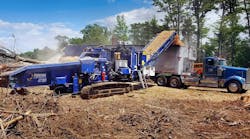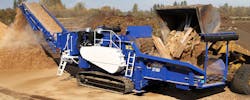Dealing with scrap materials in forestry and construction sites is no different from any other process: You want the job done as quickly and economically as possible. Transporting debris to a landfill may be an option, but recycling can be an attractive alternative if it is economically feasible. This is where processing debris on-site becomes attractive because it turns debris into a marketable commodity, such as mulch, compost, or biofuel.
Peterson Pacific Corp., Eugene, Ore., has made this type of work easier with its tracked mobile grinders. The series is used to grind a wide range of feedstock (usually pallets, railroad ties, and other waste wood); plants, tree trimmings, and other biodegradable waste; asphalt shingles; whole trees; and construction and demolition debris. This track-mounted waste recycler can maneuver over terrain too challenging for wheeled vehicles. This saves money because it can go where the work is, rather than having to bring the work to it.
The series has advantages over traditional tub grinders in that its horizontal input setup force-feeds material into a rotor. This is in contrast to the gravity feed found in open-tub grinders, which were the industry standard prior to horizontal-feed technology. The grinding rotor is located in a safer, protected housing, which helps prevent material from being ejected out of the grinding chamber. Both features are benefits of the hydraulic feed system to meter material into the grinding area.
Tracks on the Peterson Pacific’s mobile loaders allow it to maneuver into tighter spaces than wheel machines or fifth-wheel versions, resulting in higher productivity at job sites.
Operation Courtesy of Hydraulics
The operator first navigates the machine to the work area, then engages a clutch and increases engine speed to 2,150 rpm. Next, the hydraulically driven feed chain conveyor and discharge belt conveyors are engaged. Working in concert with the feed conveyor is a feed roller—a large rotating wheel above the feed chain at the entrance to the rotor housing. The feed roller normally floats on top of the load and compresses it against the feed chain with its own weight. Speed of the feed-roll motor is synchronized with the rotor (engine) speed for near-continuous feeding. The operator can raise the feed roll if a large stump or other oversized object must be processed.
The shredder’s hydraulic system plays a major role in the operation of the machine’s various functions, including:
• feed chain conveyor,
• primary and secondary discharge conveyors,
• the powered compression roller,
• the track drives, and
• the foldable discharge conveyor, which is positioned by hydraulic cylinders.
Once the machine is at the job site, the operator activates the discharge conveyors, then the feed system. If material suddenly becomes too tough or dense and object bogs down the engine below a predetermined speed, the feed system reverses to prevent stalling the engine. When the operator raises the engine speed beyond the predetermined speed, the feed system automatically shifts into the forward direction, carrying material into the grinder. The feed speed is set by the operator via adjustment of a hydraulic flow control and can be varied from very slow (less than 15 ft/min) to fast (in excess of 50 ft/min).
An adaptive feed system monitors the grinding load and varies the speed of the feed system to keep the engine working at its best combination of power and fuel economy. It accelerates the feed when the engine load is light slows when the load is high, and reverses feed when the load is excessive. The engine speed is also adjustable to suit the needs of the individual operation and material being ground. The operator can set the feed system to react to engine speed only or a combination of engine speed and hydraulic pressure at the feed chain motor to control the feed system stopping or reversing.
A wheel loader dumps pallets and other scrap wood into a Peterson 5710D horizontal grinder. A hydraulically driven feed chain conveyor moves the material into the grinding chamber.
If the operator chooses speed only, the feed system will stop if the engine speed falls below the predetermined threshold and remains stopped until the engine exceeds a higher preset speed. If speed and pressure is chosen, the feed system reverses for a preset period if pressure achieves a threshold value, then returns to forward. The hydraulic pressure sensing compensates for material blockage or an overfeed situation in the feed system. These two control methods provide nearly continuous flow without having to repeatedly stop the machine to clear jams.
The feed system can also apply a pull force in excess of 20,000 lb at the feed chain and 13,000 lb at the compression roller. The compression roller housing normally floats freely up and down on the bed of material. However, it can be hydraulically raised or lowered by the operator using either the remote radio or the main control box on the machine. This allows the operator to apply downward force to compress material or raise the roller so large, loose material can enter the grinder easier.
Finally, a hydraulic fan drive keeps the machine’s diesel engine operating within a narrow temperature band for maximum power and fuel efficiency. A hydraulic motor automatically increases speed when an electronic thermostat senses engine temperature trending too high. Likewise, in cold weather or under light load, the fan motor slows down to provide less cooling, thereby keeping the engine temperature from dropping too low.
An electronic fan control also periodically reverses rotation of the fan motor at full speed to clear any debris from the radiator to maintain effective cooling.
Continuing Development
Peterson Pacific continually tests new concepts and materials. Shredding conditions for some untested materials can be unpredictable, requiring different combinations of speed and torque. For example, southeastern palm fronds (leaves) process differently from northwestern green waste. Development to improve productivity and efficiency of machines is ongoing. This requires Peterson’s engineering department to model, analyze, and simulate new designs for new applications.




